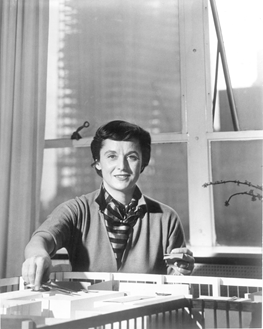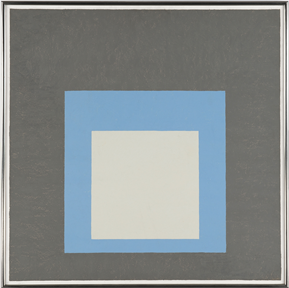Phillips to Offer
Property from the Collection of Florence Knoll Bassett
20th Century & Contemporary Art, Design, and Editions to be Offered in New York Throughout the Fall
NEW YORK – 26 SEPTEMBER 2019 – Phillips is proud to announce the sale of Making Modern: Property from the Collection of Florence Knoll Bassett, taking place across the New York auctions of 20th Century & Contemporary Art, Design, and Editions this fall. One of the most influential architects and designers of postwar America, Ms. Knoll Bassett’s enduring legacy can still be felt today, over six decades after she became president of Knoll, Inc. Comprised of nearly fifty lots in total, the collection being offered at Phillips includes works of art and design that this visionary of the 20th century chose to surround herself with over the course of her lifetime.
Vivian Pfeiffer, Deputy Chairman, Americas, and Head of Business Development, said, “Florence Knoll Bassett is among the most significant designers of the 20th century and can be credited with singlehandedly defining the aesthetic of the modern office space. While she is primarily known for her commissions and contributions to Knoll, Inc., Ms. Knoll Bassett formed an extraordinary private collection of art and design. We are honored to have been entrusted with the sale of this remarkable collection, with many of these works being offered at auction for the first time after spending decades in the home of the iconic designer.”
Florence Knoll Bassett

Florence Knoll Bassett was born in Saginaw, Michigan, in 1917 to a family of prosperous bakers and entrepreneurs. While she had a happy upbringing, she was beset by tragedy early in life, losing her parents in her adolescence. In the 1930s, she was taken under the wing of the Saarinen family, the Finnish American family who remains one of the most influential names in modern design, and was exposed to the importance of the overlapping fields of art, craft, and design, later receiving her Bachelor of Architecture degree in 1941 from the Chicago Armour Institute (today known as the Illinois Institute of Technology).
After gaining experience at architectural firms in New York, she started working for Hans Knoll as a draftsman; the two would eventually marry and she would become co-owner of the company. At Knoll, Ms. Knoll Bassett was the director of the Knoll Planning Unit—focused on its interior division—and was also the design director and critic for the development and production of the company’s furniture, textiles, and graphics. During the 1940s, she worked with designers like Eero Saarinen, Harry Bertoia and Anni Albers to create designs that fulfilled a need for modern interiors, and along the way produced innovative, high-quality furniture classics that are still relevant today.
After Hans Knoll passed away in 1955, Ms. Knoll Bassett became President of Knoll, Inc., and continued to spearhead innovations, such as the Saarinen pedestal furniture collection, and completed large-scale interior projects for companies like Connecticut General Life Insurance, Heinz, and CBS, which exemplified the best in postwar design in the United States. By 1957, she was the single most powerful figure in the field of modern design and accepted a commission to do the office interiors for bank executive Harry Hood Bassett, President of the First National Bank of Miami. The following year, the two were married, and she eventually settled in Miami, where she would go on to design other Miami interiors including the Southeast Bank and the City Club, in addition to several private residences. At the height of her career, she resigned from Knoll in 1965. She was only 48 years old, and had defined the look for corporate interiors during the 1950s and 1960s, profoundly influenced post–World War II design, and promoted the “open office” workspace through a total design approach.
Art played a central role in all of Ms. Knoll Bassett’s projects, whether they were for her larger interior commissions or for her own private homes and, in addition to collecting modern and contemporary art, she also had a passion for collecting antiques whether they be antique glass ball clocks or weathervanes. During the postwar era, she developed close relationships with designers and artists with whom she would collaborate and collected contemporary works that she treasured for decades.
Highlights from the Collection
Works from the collection will first be offered in the New York Editions auction on 25 October. The sale will feature three ceramics by Pablo Picasso, Louise Nevelson’s Six Pointed Star, and George Braque’s Astre et oiseau I (Star and Bird I) (illustrated on page three).
Following the Editions sale, an impressive selection of 20th century and contemporary art will be featured in the New York Evening Sale on 14 November. Morris Louis’ Singing (illustrated page one) will lead the group. With its cascading, prismatic bands of color, Singing exemplifies the elegant clarity that characterized Morris Louis’ production in the last year of his life. The artist made fewer than 75 pictures during his acclaimed Stripe period – the ten-month span before his death in September 1962 – and this chapter symbolized the culmination of his oeuvre. The work is a perfect example of Louis’ idiosyncratic painterly practice: after stapling canvas to his studio wall, he would pour onto it turpentine-thinned paint in a trajectory that was purely ruled by gravity and controlled chance. The results of this technique include a heightened brilliance of tone as well as a tendency for the paint to soak through the canvas to the point where the shades are almost as saturated on the verso as they are on the recto of the work. Ms. Knoll Bassett acquired Singing for $5,500 in 1963, just two years after its creation.

Rufino Tamayo’s Cinco Rebanadas de Sandía is also among the Evening Sale highlights. Executed in 1959, the work was created at a time when Rufino Tamayo’s recognition in Europe had grown exponentially, despite the persistently representational nature of his paintings in an international art scene dominated by Abstract Expressionism and Art Informel. Even as his imagery became increasingly synthesized it never leapt into complete abstraction, as demonstrated in this radically transformed still life.

Preceding the Evening Sale, examples by Josef Albers, Lyonel Feininger, Paul Klee, and Victor Vasarely are among the works from the Knoll Collection to be included in the Day Sale of 20th Century & Contemporary Art on 13 November. The last group of works from the collection will be included in the Design auction on 17 December, which will feature an important selection of 19th century weathervanes from Ms. Knoll Bassett’s collection (illustrated page three). Phillips’ exhibitions leading up to the auctions mark the first time that many of these artworks have even been on public view.
